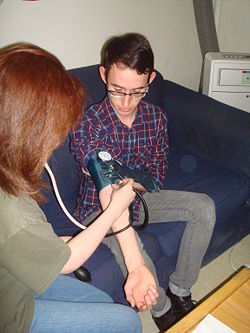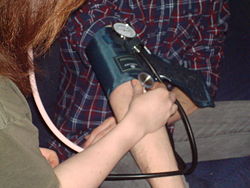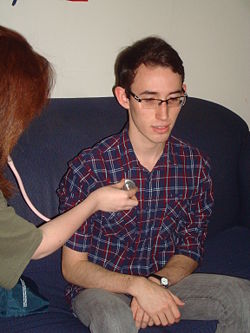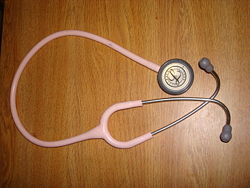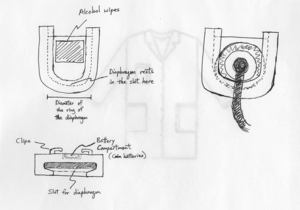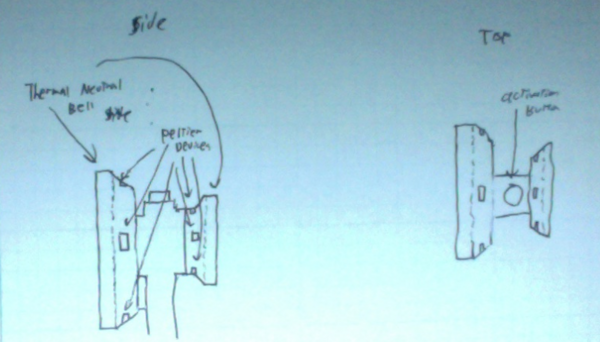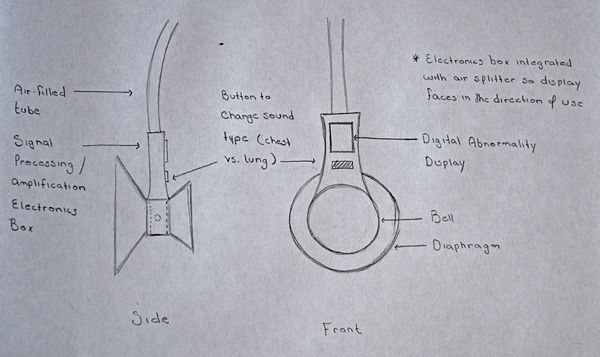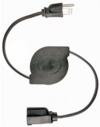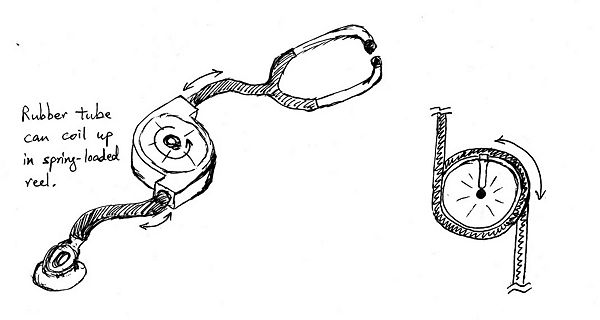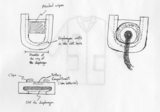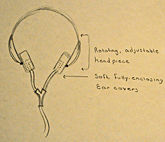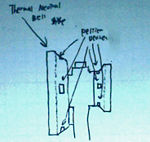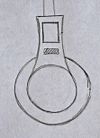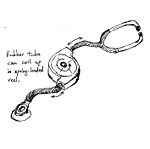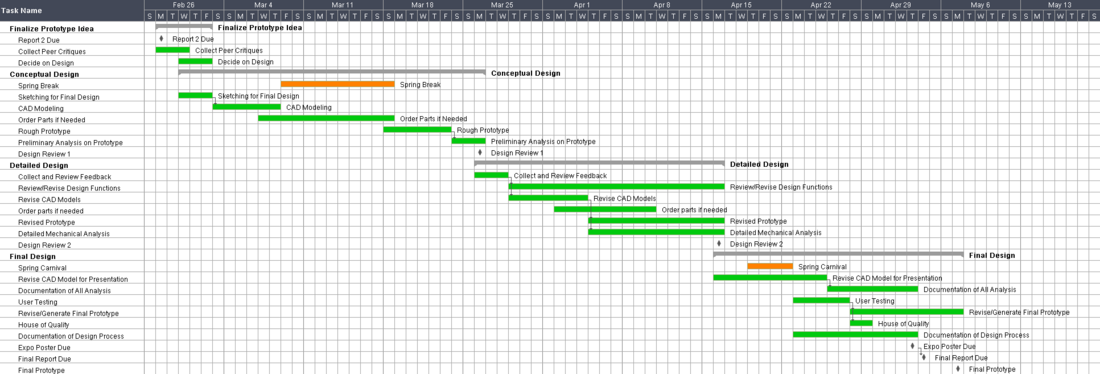Stethoscope opportunity
From DDL Wiki
Contents
|
Group Information
24-441 Spring 2012, Group 3
Kellen Chow Team Leader, User Interview Lead
Jacob Divone Observation Lead, Concept Designer
KinHang Leung Schedule Coordinator, Concept Designer
Cecily Sunday Market and Secondary Research Lead, Concept Designer
Report 2 - Opportunity: Market Research and Design Concepts
Executive Summary
Our group was tasked with determining several innovations surrounding the use of the stethoscope. In order to determine the needs of our stakeholders (determined in our previous report) we interviewed several stethoscope users and preformed secondary research regarding the technology of the stethoscope. We also conducted a user study by observing an EMS training session here on the CMU campus. From our user interviews, research, and observations we determined several product needs (including earbud comfort, sound quality and sterilization of the stethoscope).
Based on these stakeholder interviews we were able to come up with 75 innovations. We narrowed down these innovations based on our experiences with the product and what we determined to be feasible in the span of one semester. After analyzing our top designs with a Pugh Chart and weighing our options for the rest of the semester, we decided to pursue the concept of a headset redesign. Using a Gantt Chart we mapped out a preliminary schedule for the rest of the semester.
Market Research and Observations
Anthropological Observation
An anthropological observation on stethoscope use was conducted during a training session for the Carnegie Mellon University EMS team. This training session covered how to properly use the stethoscope during a blood pressure analysis as well as the procedure for checking lung sounds. Following the observation, the trainees were asked to answer a series of user interview questions.
Using the stethoscope appeared to be an easy process, even for trainees. The female EMS student only used only one hand to place the chest piece and did not verbalize any complaints about difficulties identifying the correct sounds. However, the observation was conducted in a low-ambient noise atmosphere. Answers to the interview questions provide greater insight into the user's experience than the observation. These responses are discussed in the following section.
User Interviews
To gain a better understanding of a user's experience with this product, a series of 11 questions were generated related to a user's choice, use, and opinion of their product. Question responses help identify key stakeholder needs as well as potential design opportunities. The following stakeholders were interviewed:
- A trauma Surgeon
- A clinician (the current director of Student Health Services)
- A retired nurse (retired after 35 years of experience)
- A practicing nurse (with 3 years of experience outside of school)
- A 1st year Medical Student at the University of Pennsylvania (currently completing a hospital rotation program)
- A medical intern
- Carnegie Mellon University EMS Team Members (both experienced and new members)
User Interview Questions
Choosing the Product
- How did you select which stethoscope to buy?
- How did you research your options?
- What factors played the biggest role in your choice?
Using the product
- How were you taught to use this equipment (in a class, on the job, etc.)?
- Do you warm up, clean the face of, or do anything else to the stethoscope prior to using it on a patient?
- Does your stethoscope perform equally well in all conditions (temperatures, background noises, etc.)?
- How often do you buy a new stethoscope? Why do you buy a new one?
- What type of maintenance operations do you perform on your stethoscope?
- How do you carry the stethoscope and why (around neck, in pocket, etc.)?
Suggestions for Improvement
- What don't you like about this product?
- How would you suggest improving this product?
Summary of User Interview Results
Stethoscope selection
- Hospitals sometimes receive a discount for supplying a particular product
- Parts must be easy and inexpensive to replace(especially for medical student)
- Ear comfort is very important, particularly for nurses
- Littman products are durable and come with replaceable parts
- High sound quality important
- Asking around lets you know which brands are useful
- Aesthetics matter
- Cannot be a great loss if it becomes lost or stolen
- Must take into account:
- Type of patient you will be working with (human vs. animal)
- Size of patient (child vs. adult)
- If you have a specialization or will be listening to all sounds
Stethoscope Use
- Used cheap ones until figured out what the assigned environment and specialty would be
- Carry in pocket, around neck if no pocket
- Wipe down earbuds with alcohol wipes
- Rarely clean tubes and diaphragms
- Rub diaphragm with palm to make warmer
- Wash bell with ETOH swab after every day
- Patients in isolation have special stethoscopes that do not leave their room
Difficulties and Problems
- Difficult to hear in loud ambient noise (e.g. loud emergency room)
- Hairy surface causes unwanted noise
- Harder to examine larger people
- Problem with diaphragm cracking and drying up because of alcohol wipes
- Extra weight on neck causes discomfort
- Carrying in pocket causes stethoscope to hit obstacles while walking
- Stethoscope chest pieces are rarely cleaned
- Heavy and cumbersome, especially double tube designs
- If worn around the neck, can get caught in hair and be in the way when on the phone
- Ambient noise very big problem, esp. in ER or even with A/C
- Earbud angle is very awkward and uncomfortable
- Electronically amplified stethoscopes are bulky and awkward to store and use
Suggestions for Improvement
- Warmer for diaphragm
- More comfortable earbuds
- Overall reduced mass
- Clip on lab coat for stethoscope
- Snap-on earbuds instead of screw-on
- Amplify diaphragm on top of tubes, not by the chest piece
- Abnormality indicators to help students identify noises
- Antibacterial surface on bell
- Noise-cancelling headphones or earbuds
Product Reviews
Reviews on existing stethoscopes are available via numerous publications and online user forums. The purpose of this section is to present the results of two different acoustic-property comparison articles. These article compare the sounds quality of several popular stethoscope selections. Online reviews address other user concerns such as stethoscope comfort, durability, and overall product quality. A summary of results discovered in online user reviews can be found in the Competitor Product Research section.
A study conducted by the Department of Internal Medicine at St. John’s Hospital compares a variety of stethoscopes produced by Littmann, Hewlett Packard, Tycos-Harvey, and Allen Medical Services. An analysis on the acoustic properties of these stethoscopes reveals that the bell component on the chest piece creates greater low-frequency amplification than the diaphragm with the exception of all Littmann models. The Tycos-Harvey product attenuated sound at the low frequencies more so than all other products. For the most part, there seemed to be insignificant differences in sound transmission between the different products but the Littmann Cardiology II stethoscope was judged to have the best overall performance. As we learned during user interviews, medical professional appear to agree with this conclusion since many purchase this product regardless of whether or not they are cardiologists.
A study from the Institut de Reserches Cliniques de Montreal compares acoustic and electronic stethoscopes. This work selected products made by Tycos-Welch Allyn, Littman, Hewlett Packard, Graham Field, Bosch and Starky and evaluates each device based on the quality of various heart sounds (S1, S2, S3, S4, diastolic rumble, systolic and diastolic murmurs, carotid bruit, and opening clicks), crispness of sounds, isolation from ambient noise, general utilization, and comfort. Identified limitations of the acoustic stethoscope include sound amplification, attenuating higher frequencies, and isolating ambient noise without adding excessive pressure to the ears. While the electronic models correct the acoustic limitations, they suffer in performance from added electronic noise, decreased durability, and poor ergonomic design. This study illuminates some tradeoffs of using electronics to improve acoustics. Medical professionals interviewed earlier in the market research process indicated that electronic stethoscopes are used far less often than acoustic stethoscopes. Therefore, we can conclude that additional features to improve sound amplification or to help dampen ambient noise will not be accepted by users unless the overall durability and ergonomics of the original design are maintained.
(See the Reference section for comparison study citations)
Secondary Research
Stethoscope cleanliness continues to be a popular topic of both user's and patient's concern. Numerous studies have been conducted to assess the rate and type of bacteria growth on diaphragm faces as well as how efficient various cleaning methods are on these surfaces. A study conducted by The Society for Healthcare Epidemiology of America (SHEA) in 1999 revealed that only 22% of 237 interviewed doctors regularly cleaned the chestpiece of their stethoscope with either alcohol or soapy water and that less than 11% of the surveyed doctors warmed the face of the diaphragm before use. 192 of the 237 subjects provided their equipment for bacterial cultivation. It was discovered that 71% of the samples showed significant bacterial growth and that anywhere from 2 to 5 bacteria species commonly reside on stethoscope diaphragms. In a 1995 British study, experts monitored the amount of bacteria buildup on the diaphragms of stethoscopes used in a neonatal intensive care unit by comparing two scenarios during a six-week period: In scenario 1, bacteria growth was observed when no cleaning policies were implemented and in scenario 2, growth was observed when an alcohol-cleaning policy was mandated in the wing. This study found a 30% reduction in bacteria growth in Scenario 2. However, this study fails to indicate whether or not this reduction has significant effects on the health of infants. From these studies, we can conclude that stethoscope sanitation is a relevant topic of concern and that there is potential for interest in a new or revised product to address the issue of bacterial growth.
As part of our secondary research, we also consulted literature explaining the theory behind stethoscope design. In particular, we focused on factors that influence acoustic quality and sound transmission. Specific publications on this topic include a number of articles sponsored by the American Heart Association. In one article on transmission and filtration patterns, 28 un-altered stethoscopes were tested against an artificial ear for frequency and intensity detection. This study concluded that a trumpet-shaped bell with double tubing creates the greatest mechanical sound amplification and that single tubes and shallow bells dampen higher frequencies. This article identifies a method by which to test and analyze the acoustics of the stethoscope and confirms that tube length, tube diameter, bell curvature, and diaphragm size all affect the acoustics of the stethoscope.
(See the Reference section for secondary research citations)
Top Stakeholder Product Needs
Based on the anthropological observation, user interviews, and market research, the following 5 criteria were identified as top stakeholder needs:
- Good sound quality (i.e. reduced external noise)
- Ergonomics (low weight, easy to handle, easy to transport)
- Durability
- Headset comfort
- Easy and effective sterilization
All stethoscope design opportunities should hold these needs at the forefront of design considerations. Secondary criteria that should also be considered includes product safety, manufacturability, cost, and aesthetics.
Stethoscope Design Opportunities
Five stethoscope design concepts were developed based on the identified stakeholder needs. These concepts focus on improving the product for the both patients and users and will be analyzed in comparison to each other and a competitor product to determine their practicality and potential for development.
Design 1: Coat Integration with Heater and Sanitizer
In order to address the stakeholders' need for a light-weight, self-heated, self-sanitizing and easily portable stethoscope, this design aims to integrate a stethoscope onto an average doctor's coat. By attaching the stethoscope onto the coat, the weight of the stethoscope is distributed over the user's shoulder through the coat, improving its portability and eliminating stress on the user's neck. The diaphragm holder will also act as a heater (keeping the diaphragm surface around average body temperature) and a sanitizer (cleaning the diaphragm surface after each use).
Potential Design Opportunities:
- Integration should not affect the manufacturing of the coat; the design should focus on making mechanisms on the stethoscope that would easily attach to an average doctor's coat
- Integrating the tubes inside/under the collar - What kind of attachment mechanism...Pins? Velcro? Adhesive? Clips?
- Mounting the heating/sanitizing holder on the chest area of the coat - What kind of attachment mechanism...Safety Pins? Clip? Velcro?
- Alternate material selection for a light-weight design
- Designing the appropriate and low-cost heating element - Drawing heat from user's body? Battery-powered?
- Designing the sanitizing element - Alcohol patches in the holder must be easily replaceable
Design 2: Headset Redesign
During user interviews, numerous complaints arose in association with the stethoscope's headpiece. In order to hear properly, the holes in the ear pieces should be directly aligned with the user’s ear canals. However, this task is made difficult by the stiff body of the full headset and the often un-customized size of the ear buds. In environments with extraneous background noise, medical professional often hold the headset in place with one hand with using the other to place the chest piece. Other issues associated with the headset include general discomfort, problems with the ear buds unscrewing and getting lost, and cracked or dried-out ear pieces due to frequent cleaning with alcohol wipes.
Design 2 aims to address the numerous user complaints that center around the headpiece while maintaining the sound quality, durability, and portability of the original product. In place of the ear buds, this design uses headphone cups that will go around the user's ears as opposed to inside of them. This not only helps to block out excessive background noise, but provides a comfortable and effect solution for directing sound without customized pieces.
Potential Design Opportunities:
- The metal band connecting the headphone cups should be adjustable to fit all users
- The metal band should swivel about the earphone cups so that users can wear the band on the head or below the chin according to their preference (see picture of Design 2)
- The metal band connecting the headphone cups should allow users to wear the headphones around the neck or the shoulders according to preference (see picture of Design 2)
- The air must be carefully transferred from the tubes to the hole on the inside of the headphone cups so that no sound is lost. This can be done by creating a hollow, airtight path with either metal or plastic
- The headphones should come with an attachment kit so that they can be sold separately and easily replace the headset of an existing stethoscope
Design 3: Peltier heated stethoscope head
Through our market research, we learned that patients consistently complain that the stethoscope is too cold when it touches their bare chest or arm. In order to reconcile this, a heating device (peltier cells) could be added to the head of the stethoscope. Given the right current, the air could heat up, causing the head of the stethoscope to heat up to a warm temperature. To ensure it doesn't get too hot and potentially burn either the patient or the health care provider, the ring holding the drum in place will be replaced with a rubber material.
The peltier cells in this design are dispersed in the drum holder, with the heating side facing towards the drum and the cooling side facing outwards. The idea behind this is that the heating side of the peltier cells will heat the air incased in the stethoscope, which will make the stethoscope warmer to the touch. The activation button will conveniently be placed on the splitter so it is within easy access and will act as a simple on/off switch. Issues that may arise with this design include finding a non-bulky solution for powering the cells and ensuring that the heated air does not affect the acoustics of the stethoscope.
Potential Design Opportunities:
- The peltier cells could add some significant cost to the stethoscope (adding anywhere from 30-100$)
- Power source should be kept at a minimum because you dont want a huge change in temperature and for the peltier cells to damage any of the surrounding materials
- The thermo-plastic should act as a bad thermo conductor. This is to ensure that the patient and the healthcare provider dont get burned from the hot air
Design 4: Abnormality Indicator
Both the medical student and the young nurse interviewed during our User Study indicated that one the most difficult tasks associated with using the stethoscope is becoming familiar with abnormal heart, lung, or bowel sounds. This is especially difficult in situations with loud background noises. One possibility for a redesign of the stethoscope is to create a way to alert the user of abnormalities. This will help medical professionals, and students in particular, know when they should pay specific attention to one sound over another.
Littmann, one of the most frequently-selected stethoscope manufacturers, offers an electronically amplified stethoscope in the range of $300-$400. These stethoscopes amplify sound via an electronics box located at the base of the air-filled tube. The electronics box has a digital read-out for sound level, battery level, and heat rate. The electronics in this product are also responsible for controlling the frequency of sound that is transmitted through the instrument. This way, only a single diaphragm is required. The idea behind Design 4 is to use signal processing to analyze the the detected sound waves and alert the user of any abnormalities. This feature can be integrated with the existing electronics of the Littmann amplified stethoscope or can be made as a separate product. One reason for using a sound indicator without an amplifier is to keep the design as simple as possible to reduce the size and the cost of the added components. The sketch of Design 4 illustrates an abnormality indicator as a separate product. In this design, the electronics box turns with the splitter to make it clear to the user which diaphragm is in use. A digital read-out on the box will display a letter that indicated which abnormality is present. For example, an 'M' will indicate a heart murmur.
Potential Design Opportunities:
- The added electronics must not be heavy, bulky, or fragile. This can be accomplished by adding as few electronic features as possible. For example, add signal processing capabilities but not amplification
- Indicator should have a feature to identify which types of sounds are being listened to (i.e. heart, lung, or bowel sounds). This will simplify the signal processing design
- An electronically amplified stethoscope with an abnormality indicator would be useful for training purposes even if it is not practical for every-day use.
Design 5: Retractable Tubing
It is common practice for frequent stethoscope users to purchase a stethoscope with a long air tube and cut the tube to a shorter length themselves. Shorter tubes produce better sound but taller users require longer tubes so that they do not have to bend over or be unnecessarily close to the patient during examinations. An easily-adjustable tube would save users the task of customizing or making irreversible changes to their own equipment; Design 5 provides a solution to such a tube. The concept is inspired by the idea of a retractable cord reel mechanism on computer mouses and power strips. By integrating the cord-winding mechanism on the stethoscope, it will make the stethoscope more portable and less bulky.
This design requires further research on how most retractable cord-winding mechanisms work and perhaps performing another product dissection and reverse-engineering exercise. The basic idea is that the rubber tube of the stethoscope can be winded up on a reel when not in use. User just needs to simply pull the diaphragm and unwind the rubber tube for extending the reach. The reel has a one-way snap torsional spring, so that it holds the length when the user first pulls it, but a secondary pull will disengage the snap and the torsional spring winds up the rubber tube back around the reel.
Competitor Products Research
Online Product Reviews
Several online sites were consulted to research the effectiveness of competitor products. The sites included independent sites such as Stethoscope Reviews, online magazines such as ForUsDocs.com and online retailers such as Amazon.com. From these reviews we were able to gain some insight into stakeholder needs (links to the specific reviews are in the Reference section below). A summary of the online reviews are listed below:
- Blocking ambient noise is extremely important, especially for those working in emergency situations (ER, ambulance, etc.)
- The "quality" of the stethoscope sound was mainly divided into two factors: the ease of detection of high & low frequency sounds and the lack of noise caused by external sources (i.e. rubbing diaphragm against chest). The ideal stethoscope sound would have an intuitive method of differentiating between high and low frequency sounds. It would also block out any external sounds such as scraping and ambient noise.
- Size of the stethoscope was important to doctors and surgeons, especially those running around often. Having a small and portable, yet functional, stethoscope was the ideal design.
- Littmann brand stethoscopes were the top brand in every online review
- Pricing is a very important factor, especially for those just starting out (i.e. medical students, nursing school students). Several reviews by medical students mentioned that it was not worth it to pay more for a Littmann stethoscope.
The reviews online closely mirrored the interview responses that we gathered. We have determined that the top choices for innovation are earbud comfort, sound quality and portability.
Pugh Chart
The competitor product selected to help analyze the five ideas proposed in this report is a dual-head, single-tube Littmann stethoscope. This is a commonly selected and recommended stethoscope with no special features that will change its cost, durability, or functionality to an excessive degree. A Pugh chart is used to compare the proposed designs against the datum using eleven different criteria. The criteria and weights were chosen based the stake-holder needs that were identified during research and User Study activities. A score range of -2 to 2 is used where -2 indicates a significantly problematic deviation from the datum point and a score of 2 indicates a significant improvement from the datum. A 0 indicates a neutral point or an quality of equal comparison to the datum point. The weighted totals calculated in this analysis indicate the degree to which each design performs in comparison to the Littman Stethoscope. The weighted total does not however provide accurate insight regarding the feasibility of creating each design as only one criteria, manufacturability, addresses this issue.
Design 1 Comparison Results
The coat integration design is compared to a standard stethoscope instead of an average doctor’s coat, because the main design task is to modify the stethoscope and design the holder for attaching both items to an average coat. We decided that Design 1 is more comfortable because the weight of the stethoscope is distributed over the user's shoulder through the coat, compared to conventionally carrying the stethoscope around one's neck. It’s also safer because the integration prevents user from dropping the stethoscope and from banging it into something else. The design really excels in portability since it is now part of the user’s coat. It also tackles one of the most important needs of the stakeholders, which is the sterilization of the diaphragm after every use. However, due to the addition of the diaphragm holder, the design will require a higher manufacturing cost.
Design 2 Comparison Results
Based on the identified criteria, Design 2 has a positive weighted total of 9 above the competitor product. It was determined that the headset would be easier to handle because the user would not have to be concerned with the alignment of the earpieces. As long as the headset is fitted to the user’s head, the sound will be directed as necessary. Design 2 ranked high for improved comfort because soft, deformable headphone cups replace awkwardly sized or potentially hard-plastic ear buds. This redesign also improves noise cancellation capabilities because the entire area surrounding the ear will be tightly enclosed. Finally, this design had a positive score on sanitation because the new headset does not require alcohol-based cleaning. Due to the added complexity of the new headset, both cost and manufacturability received negative scores. The durability of this design will also be affected depending on the selected material.
Design 3 Comparison Results
Design 3 received a positive score of 2 for comfort. However, this wasn't because the redesign made the device more comfortable to be used by the medical professional. Instead, it made the device more comfortable for the patient. That said, manufacturability, cost and safety all went down from the standard stethoscope. Safety received a negative value because if the peltier devices were to heat up any metallic portion of the stethoscope unnecessarily, there would be some danger for the medical professional or even the patients. Manufacturability for this design will be more complex than for the standard stethoscope because the space for the peltier cells must be machined out. Cost also experiences a negative change because this model will be significantly more expensive than the standard stethoscope. Given these criteria, we decided this design was not the best means of heating the stethoscope's diaphragms.
Design 4 Comparison Results
An abnormality indicator makes the stethoscope easier to use because it directs the user’s attention to a specific area of need. Ease of use is the only criteria with a positive gain for Design 2. The specific design illustrated and discussed in the above section does not use electronic sound amplification in conjunction with signal processing. If it did, noise transduction would be given a score of positive 2. Design 4 received a negative score for comfort because the electronics added to in the chestpiece area will make the devise more cumbersome and awkward to handle. The addition of the electronic box also negatively influences the scores for the durability and portability because of its fragile, bulky nature. Furthermore, the complexity of this addition will increase the cost and decrease the manufacturability of the stethoscope. Although Design 4 had an overall negative weighted total, this idea may still be worth pursing because of the benefits it would provide to trainees and students.
Design 5 Comparison Results
Retractable tubing will improve the ease of use for a stethoscope, as the diaphragm could be shortened or extended as the user sees fit. It is also safer because the user does not have to deal with the long swinging tube when the stethoscope is not in use. Having the stethoscope winded up when not in use also makes it more easily portable. However, the additional cord-winding mechanism will most likely cause extra disturbance noises in the tubing. It will also be more costly to manufacture and assemble the additional mechanism over the standard stethoscope. The design will reduce the robustness of the stethoscope because the additional mechanism would have a high likelihood of failure.
Pugh Chart Comparison Conclusions
Based on its weighted total of positive 11 on the Pugh chart, Design 1, or the coat integration design, is the most advantageous stethoscope design opportunity to pursue. Design 2, or the headset redesign idea, closely follows Design 1 with a weighted total of positive 9. The abnormality indicator (Design 4) seems to be the most impractical alternative to consider with a weighted score of negative 12. However, this device was judged based on the needs of average stethoscope users, not the small market of trainees who this device would appeal to. Students make find that the benefits of using this device for short-term training outweigh its negetive qualities. Design 4 should therefore still be considered for prototyping.
Gantt Chart
In order to keep track of our progress and better organize ourselves in the upcoming months, we have planned out our project with a Gantt Chart. This is a very useful way to keep ourselves on task and be aware of the order of things to get done. We created our Gantt Chart using a free online project management tool named "Smartsheet" (see Reference).
Conclusions
Recommendations
The design concept of the Headset Redesign addresses the most pressing issue brought to our attention from our user study. The potential product will enable medical professionals to better hear the sounds they need to hear under various ambient conditions, and it will provide extra comfort to the user. Although our Pugh analysis showed that the Coat Integration Design has the most positive attributes out of all the designs, we determined that the Headset Redesign is more feasible given our time left in the semester, and it has relatively more mechanical design opportunities. This design concept may also be further explored and be implemented for other non-medical purposes. All of these reasons lead us to recommending our Headset Redesign of the stethoscope as the focus of our project for the rest of the semester.
User Scenario
Below are two hypothetical user scenarios, highlighting the features of our proposed Headset Redesign.
Stuart is a paramedic (First Responder). He spends much of his time on duty riding in the back of an ambulance and treating patients as they make their way to the hospital. A stethoscope is a necessary tool for him as assessing vital signs is one of his primary objectives as a First Responder. Stuart treats the patients on the scene as well as when they are in the back of the noisy ambulance so hearing the stethoscope sounds over the ambient noise is a problem. Portability is another key factor as he is constantly moving around. An ideal stethoscope would not get in the way as he attempts to maneuver around the back of the ambulance. It would also block out much of the ambient noise (e.g. bystanders talking, ambulance sirens, etc.). Our proposed innovation is designed to reduce ambient noise interference and increase sound quality. It would also make the stethoscope user more comfortable as the headphone design is more accommodating to the ear shape than the traditional plastic earbud design.
Susan is a registered nurse. She spends much of her time in the Intensive Care Unit (ICU) in the hospital. When she uses her stethoscope she needs to be able to listen for abnormalities such as heart murmurs. Since the ICU is a very busy place (i.e. doctors running in and out constantly) it can get noisy and difficult to hear her patients' body sounds. In addition, her head and ears are slightly smaller than the average doctor. The traditional rigid metal headpiece design does not fit in hear ear canal correctly and causes her pain. She has to use one hand to redirect the earpieces and the other to hold the bell, leaving her no free hands to move the patient. Our proposed design would cut out the ambient noises, making it easier for her to hear the patients' body sounds. The adjustable headpiece would fit around Susan's head and the headphone design would not dig in to her ear canal like the earbuds would. By having a properly fitted headpiece Susan is free to move the patient as needed with her free hand.
Group Member Responsibilities
The tasks for this report were equally distributed among all group members. Each individual was responsible to conducting atleast one user interview, observation, or research activity. After collecting all information, we met to discuss our findings and begin generating design opportunity concepts. Each member created sketches and descriptions for a minimum of one idea that we discussed as a whole. Likewise, the Pugh chart analysis was a collaborative effort. Finally, we worked simultaneously on compiling our report on this wiki page. Kin created the Gantt chart while Kellen compiled the presentation and Cecily and Jake formatted and edited the final report.
75 Design Opportunity Ideas
Air-tube Alternatives
- Water filled tubes
- Alcohol filled tubes
- Oil filled tubes
- Replace air-filled tubes by electronic wires (headphones cables)
- Retractable stethoscope tubing
- Telescoping stethoscope tube
- Extra clip on tube to attach stethoscope to a pocket or lab coat
- Tubes made of a more elastic material so they can be short but extended when necessary
- Eliminate the tubes and project the sound directly to the surroundings
- Eliminate the tubes, record the sound, and play it back through a regular audio device
Headset Alternatives
- Snap-on earbuds instead of screwed-on
- Noise-cancelling headphones
- Noise-cancelling earbuds
- Rubber earpieces
- Silicone earpieces
- Sleep plug earpieces
- Completely-covering ear cups
- Bose styled head set
- Gel filled ear pieces
- Adjustable triple leaf spring
- Suction cup ear muffs
- Adjustable head band connecting ear pieces
- Headset band that swivels about the earpieces
- Attachment for a second headset so a trainee can listen to the same sounds as their instructor
- Sound-amplification through the headset
Chestpiece Alternatives
- Snap-on diaphragm for easy replacement
- Aperture style diaphragm
- Disposable diaphragm surface/film
- A diaphragm heater using Peltier cells
- Replace diaphragm material with self-sanitizing brass
- Sonar sensor instead of diaphragm
- Adjustable drum
- Changing tribology of the drum to lower noise produced from sheer forces
- Shapeable/moldable diaphragm and bell
- Bell that transforms into a diaphragm
- Sound recorder integrated with diaphragm (used for training in future)
Stethoscope Integration Products
- Blood pressure cuff interface
- Diaphragm heater and holder integrated on coat (battery)
- Alcohol pouch integrated on coat
- Coat pouch/clip around the chest area
- A coat pouch/holder that heats and cleans the diaphragm
- Integrating tubes in the coat sleeve and the diaphragm in the cuff
- Hugging stethoscope coat (integrated in the coat so user hugs the patient during use)
- Integrating a heart rate monitor on chestpiece
- Integrating a murmuring sound indicator on chestpiece
- A hand-held separate heart rate monitor (connects to chestpiece by wire)
- A hand-held separate heart rate monitor (Bluetooth)
- Bluetooth connection to user's mobile device (like an app)
- Integration of a respiratory rate indicator
- Integrate visual display of sound
- Integrated with pulse oximeter
- Integrating recordable lung sounds
- Timer stethoscope
- LED abnormality indicator
- Electronically controlled signal processor
- Low and high pass filters to eliminate noise and select specific sound waves to listen to
Other Ideas
- Hooked up to visual display on eyeglasses
- Integration of the stethoscope on dummies that create sounds for medical training
- Heated fluid in stethoscope for comfort
- Speaker output stethoscope
- Speaker integration stethoscope
- Broadcasting noise for training purposes
- Golf ball cleaning system
- Air blasting cleaning system
- Magnetic stethoscope holder
- Amplification through mechanical resonance
- Bio-inspired sound amplification using inner ear drum
- Signal processor at junction
- Heated stethoscope holster to keep stethoscope at comfortable temperature
- Break away security system
- Stethoscope flashlight
- Remove metal to ensure stethoscope doesn't get cold
- Bedazzled headset and chestpiece for professionalization
- CD set of stethoscope noises to help learn the sounds
- Small training device implanted with relocating, changing sounds
- Non-alcohol based cleaner so parts do not dry out
Reference
Abella, Manual, Formolo, John, Penney, David G. Comparison of the Acoustic Properties of Six Popular Stethoscopes. Journal of Acoustics. Volume 91, Issue 4. April 1992. Pages 2224-2228.
Acoustic Stethoscope Review, ForUsDocs.com - [1]
Amazon.com review of a Littmann Cardiology III Stethoscope (accessed Feb. 26, 2012) - [2]
Bernard, Lewis et al. Bacterial Contamination of Hospital Physicians’ Stethoscopes. Infectious Control and Hospital Epidemiology. Volume 20, Number 9. September 1999. Pages 626-628.
Dolan, Thomas G., Oliver, Sara R., Maurer, James F. Stethoscopes: real-ear measurements and digital frequency transposition. Journal of Hearing. Volume 54, Issue 1. January 2001. Pages 36-44.
Ertel, Paul Y., Lawrence, Merle, Brown, Richard K., Stern, Aaron M. Stethoscope Acoustics: II. Transmission and Filtration Patterns. Journal of the American Heart Association. Issue 34. 1966. Pages 899-909.
I.M.R. Wright, H. Orr, C. Porter. Stethoscope Contamination in the Neonatal Intensive Care Unit. Journal of Hospital Infection. Volume 29, Issue 1. January 1995. Pages 65-68.
Marie-Claude Grenier MSc, Katerie Gagnon ID, Jacques Genest Jr., MD, Jocelyn Durand BEng, Louis-Gilles Durand PhD. Clinical Comparison of Acoustic and Electronic Stethoscopes and Design of a New Electronic Stethoscope. The American Journal of Cardiology. Volume 81, Issue 5. 1 March 1998. Pages 653-656.
Review of a Littmann Master Cardiology Stethoscope - [3]
Smartsheet Online Gantt Chart Tool - [4]
